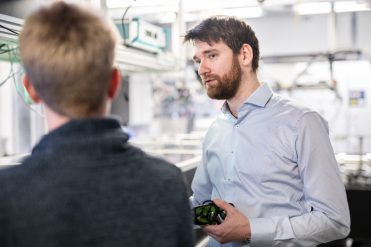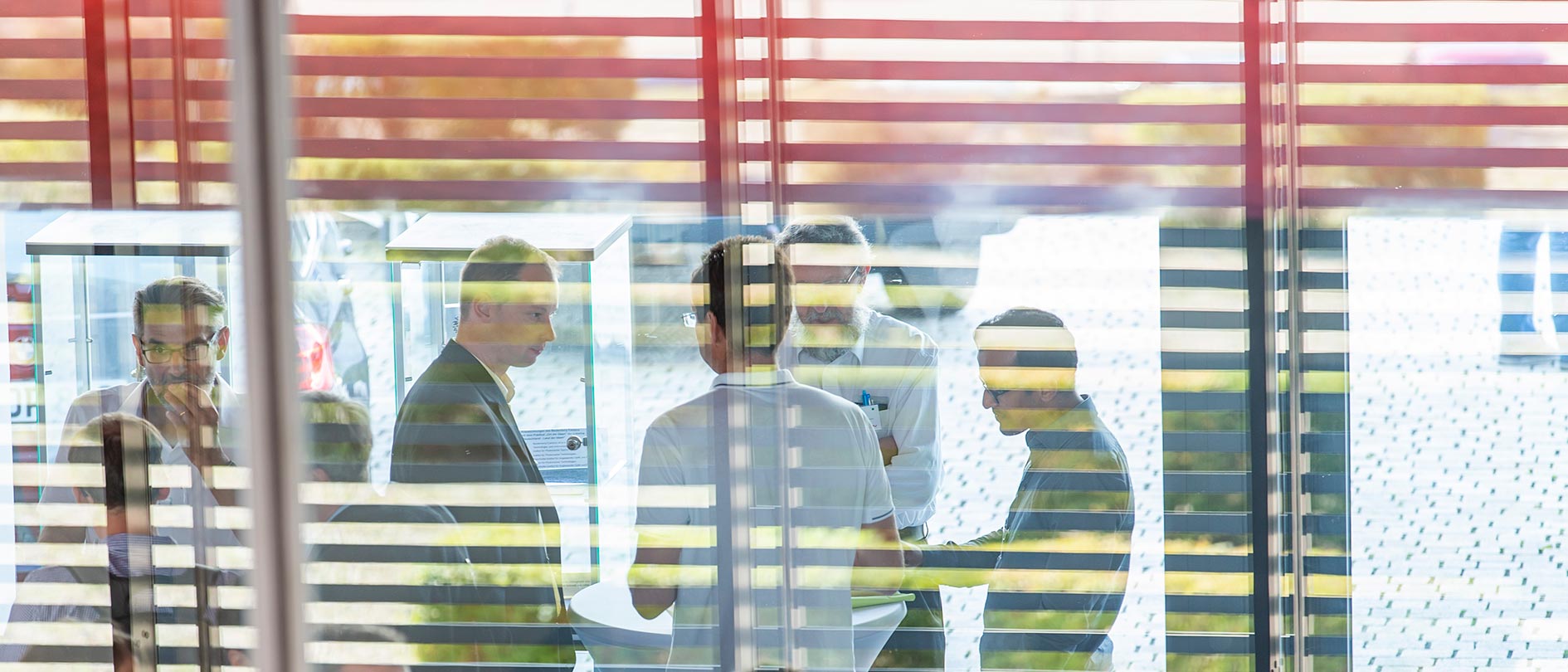News › Fraunhofer IOF · Full EUV power on a small laboratory scale
The future has a color: it is extremely ultraviolet. Light in this particularly short-wave spectral range, so-called EUV light, can be used, for example, to produce smaller and more powerful microchips than ever before. But further research faces a problem: Experiments with laser-like EUV light can so far usually only be conducted at expensive large-scale research facilities. Jena researcher Robert Klas wants to change that. He has developed a compact EUV laser module that can be used to generate this special light much more easily and cost-effectively. Particular potential applications are conceivable in semiconductor manufacturing and microscopy. Robert Klas has now been awarded the Hugo Geiger Prize for this work.

Researcher Robert Klas from Jena has developed a compact module for generating laser-like EUV light as part of his doctoral thesis. Where research facilities the size of an entire house have been necessary until now, so-called synchrotrons, Klas now presents with his dissertation a new and efficient method to generate laser-like EUV light in a facility the size of a laboratory table.
Klas‹ doctoral thesis, which is the result of cooperation between Friedrich Schiller University Jena, the Helmholtz Institute Jena and the Fraunhofer Institute for Applied Optics and Precision Engineering IOF, provides the most powerful laser-like EUV source on a laboratory scale to date, with an average power of 10 milliwatts – a hundred times more power than was common in comparable systems when he began his doctorate. This will make EUV research independent of a few large-scale facilities that are costly to maintain. What’s more, the compact setup costs only a fraction.
EUV source on a laboratory scale with a hundred times more power
Klas‹ work addresses a key challenge in laser optics. An important principle in this field is that the shorter the wavelength, the harder it is to generate laser radiation. In his work, the physicist is working in the wavelength range from 10 to 50 nanometers. One nanometer corresponds to one millionth of a millimeter. In short, extreme ultraviolet light is extremely difficult to generate as laser light.
To solve the problem, Klas uses modern high-power ultrafast lasers. These are converted into EUV light by means of the process of generating high harmonic radiation. To do this, Klas first focuses the high-power laser in a noble gas. In this process, electrons are accelerated within a few 100 attoseconds. An attosecond is one trillionth of a second. Robert Klas illustrates this order of magnitude with a comparison: »An attosecond relates to a second like a second relates to our world age,« he explains. The electrons accelerated in this unimaginably short time subsequently produce the precious EUV radiation by recombining with their parent ion.
The great challenge here is to coherently superimpose the released radiation, i.e., to control it in such a way that its so-called wave crests in the extreme ultraviolet spectrum add up and can be bundled into a laser beam at the end. Through the correct choice of laser parameters as well as gas density, he has succeeded in generating EUV radiation with laser-like parameters in a highly efficient manner. Which, in combination with high-power driver lasers, led to a significant increase in EUV performance.
High-power EUV source creates novelty in high-resolution microscopy
The scientist is convinced that his work will significantly facilitate further research as well as application of EUV light: »In the future, it is expected that the results of my doctoral thesis will drive development in many important areas such as the energy and storage efficiency of chips, biology as well as medicine.«
In the process, Klas has already tested the first potential applications for his novel EUV source on a laboratory scale during his research. In particular, he has turned his attention to microscopy – specifically imaging in the tiny nanometer range – in exchange with other researchers. »With an exposure wavelength of 13.5 nanometers, we have realized a resolution of 18 nanometers,« he reports. By comparison, conventional light microscopes only manage a resolution of just under 500 nanometers. Klas uses another example to illustrate the incredible detail of the microscopy made possible by EUV light: »In one experiment, we achieved a so-called field of view measuring 100 x 100 micrometers. That means we can comparatively cover the size of a soccer field within an image and find a one-euro coin in it.«
Another innovation: With EUV-based microscopy, colored images can be created of a sample under investigation. In this way, researchers can »look inside a cell« and distinguish different elements or proportions of different substances such as carbon, lipids, etc. – »a novelty at such a high resolution,« Klas emphasizes. »With our technology, we can use it to advance biological and medical studies in the future and hopefully study different types of viruses. At some point, we also want to be able to image DNA with a diameter of about two nanometers using this method,« he says.
Quality assurance in semiconductor manufacturing using EUV lithography
The technology developed by Klas has another special potential application in EUV lithography. Here, tiny microchips are produced with the help of extreme ultraviolet light. The semiconductor industry already uses this process to apply more than ten billion transistors to a chip the size of a fingernail. A research team from TRUMPF, ZEISS and Fraunhofer was awarded the German Future Prize in 2020 for the development of EUV lithography.
Klas‹ research opens up a new possibility for quality assurance in this context. This is because the outstanding microscopic properties of his system can also be applied to an exposure mask. This is used in semiconductor manufacturing to produce the tiny EUV chips. If defects are hidden in this mask, they are passed on to the chips manufactured with it. EUV microscopy can be used to examine the mask for such defects. Detecting weak spots in the EUV mask early on and thus avoiding further errors in production saves time and money. »This process can reduce scrap and thus lead to more sustainable production,« says Klas, explaining the benefits of this method.
Awarded the Hugo Geiger Prize
Robert Klas has now been awarded the »Hugo Geiger Prize for Young Scientists« for his groundbreaking research work. The award is presented by the Free State of Bavaria and the Fraunhofer-Gesellschaft to outstanding young researchers. The award ceremony took place on March 21 in Munich. A total of three scientists from Munich, Freiburg and Jena were honored. Further information on the award and the other prize winners can be found in the press release of the Fraunhofer-Gesellschaft.
EUV light – the light for the digital age
Light in the extreme ultraviolet range, or EUV light for short, is a very special light. Due to its particularly short wavelength, it can be used to produce tiny structures. This is important in semiconductor manufacturing, for example: Here, EUV light can be used to produce ultra-fine circuits on microchips. In this way, semiconductors can be made smaller and at the same time more powerful than ever before. And it is precisely these mini-chips that we urgently need, because without them, progress in artificial intelligence and autonomous driving, for example, would be virtually inconceivable.
Until now, the generation of laser-like EUV light has only been possible in expensive and complex large-scale facilities. Researchers have to visit special research centers, so-called synchrotrons, to use these facilities. Scientists often wait for years for a place here, only to end up being able to experiment for a few weeks or even days. Research and further technological progress, which EUV light promises especially in the digital age, are thus massively hampered. Klas intends to remedy this situation in the future with its new, compact EUV source.
Contact
Roberts Klas
Fraunhofer IOF
Albert-Einstein-Str. 7
07745 Jena
Phone +49 3641 807–640
Mail ed.refohnuarf.foi@salk.strebor
